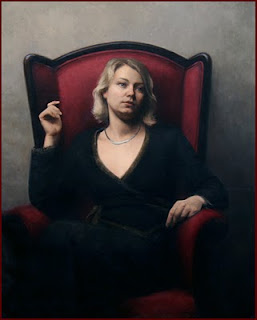
For my headpainting class, we do a report on a contemporary artist. Rather than sifting through somebody's marketing on the web, I decided to interview Ryan S. Brown so that I could ask him stuff beyond what we hear in class. He was kind enough to make an appointment with me- which became more and more embarrassing as I surfed through his stuff on line and saw how much his pieces sold for.
He's in galleries from CA to London. Right now he is doing his second one man show in Jackson. He has a list of awards as long as your arm.
None the less, He has a school, The Center for Academic Study & Naturalist Painting (CAS), in Springville So I guess he doesn't mind talking to prospective students so much.
I thought I'd record the interview here in preparation for my report for Newbold's class.
Q:After a Graduating from a University you went to Europe in search of "Academic" training. What's the difference?
A: (Paraphrased) I took headpainting at BYU 8 times. Seegmiller, barret, barksdale Etc. Etc. And looking around me, in that context, I thought I was pretty good. And that's what everyone else told me. I don't remember what took me to Florence the first time; but when I got there I was quite arrogant-- I went into the drawing class thinking I was hot stuff. But after the first three days I was quite frustrated. They were not very impressed with what I was doing, and continued to find problems in my drawing. After three days of this I realized "they want me to be perfect! Can that even be done?" After 1 week I realized, they are using all the same words I have heard before-- value, form, volume etc. But they are talking about something completely else. They wanted me to see, and it was like taking the blinders off, I was learning to see, in the same way that it has been taught since the 19th century. When I came back and taught at BYU, I would take my students to the basement of the MOA to look at 19th century drawings. And they would say, we don't draw that way anymore. It isn't because we don't, It isn't because we choose not to, It's because we can't. We have lost a visual literacy that was there in the past centuries. Now the Met in NY is proud to have 54,000 guest per year in a city of 8 million. Where the Salon des beaux Artes used to have millions attend.
Q:What did you find in Europe that you couldn't find here?
Q:?Do you make multiple studies before you paint?
A: He always does 4-5 different studies for each painting. If I remember right, he starts with a line study, just planning design. Then a Value study, working out all those complications. Then a color study in oil at the site. This is very loose very large and he completes it in an hour. Niki, one of his teachers explained that was so that he could then mix large quantities of the colors in advance of doing the work, and not have to stop the painting process to mix more colors. He also takes a photograph. Then he will get ready to paint, surrounding himself with each of the studies. He says, each study has it's own strength, you have to know the quality of each study and bring it to your finished work in order t have a solid piece of work.
Q:What motivated you choice of lighting? Do you always use cool light?
A: He said he always paints with Natural light. Artificial lights are very harsh and Real skin should be painted in real light. That is why he uses a natural Medium rather than Synthetic. Synthetics always end up making things look sick. (Q:"What's a Natural medium for example?")Maroger or walnut or linseed oil. Maroger is just black something and something else.
A:Portraiture can not be completed in a 3 hour sitting. There is no point in taking a class that meets daily for 3 hours, churning out a new head each day. In such a context, you can not develop any skills that you will use in painting a portrait. Portrait painting is a slow meticulous process. (Pointing to Jenny) I took 11 weeks 5 days a week with the model for that painting. It was very challenging because the head swivels on three axis. Portraiture must be done carefully, meticulously in order to achieve accuracy necessary. That is how Jeremy Lipking, Gotleib John Collins, do it. It is silly to do it otherwise. I paint with these men frequently. There is a literacy to art. In meeting a new artist we can tell if they have studied this way through the way they speak.
He wrote down a couple of things for me to check out:
A speach from the president of ARC calling for a return to classical painting.
* A book called, "The practice & Science of Drawing" by Harold Speed
*Grand Central Academy
*Florence Academy of Art
*Angel Academy of Art